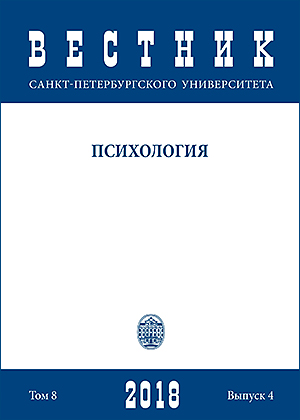Развитие привязанности у детей от одного года до четырех лет
DOI:
https://doi.org/10.21638/11701/spbu16.2018.407Аннотация
Представлен обзор исследований, проведенных в области изучения привязанности у детей, в которых продемонстрирована взаимосвязь между качеством привязанности ребенка и характеристиками материнской чувствительности к его потребностям. Также рассмотрены теоретические подходы к оценке привязанности, которые представляют разную концептуализацию развития стратегий привязанности у детей, имевших опыт значительной нечувствительности со стороны матери в период младенчества. В связи с отсутствием работ, в которых изучались стабильность и изменение стратегий привязанности от младенческого к дошкольному возрасту у российских детей, целью исследования стало изучение развития системы привязанности у детей от одного года до четырех лет, а также описание факторов, влияющих на изменение характеристик привязанности. В исследовании приняли участие 27 пар «мать — ребенок». Дети были рождены в срок и не имели нарушений, связанных с генетическими и медицинскими факторами. Оценка привязанности проводилась при помощи метода «Незнакомая ситуация» в младенческом (средний возраст детей 13,3±1,6 месяцев) и дошкольном (средний возраст детей 32,1±9,6 месяцев) возрасте. Паттерны привязанности детей определялись с использованием критериев М.Эйнсворт и П.Криттенден экспертом, прошедшим обучение. В ходе исследования было выявлено, что у 22,2% детей к дошкольному возрасту паттерн привязанности изменился. Изменение паттерна привязанности оказалось связано с наличием признаков депрессии в младенческом возрасте и посещением детьми детского сада. Такие характеристики, как наличие сиблингов, другого заботящегося лица (няни, бабушки), посещение развивающих занятий или игровых групп, а также возраст дошкольников, оказались не связанными с изменением паттерна привязанности у детей в возрасте от года до четырех лет.
Ключевые слова:
привязанность, ранний возраст, дошкольный возраст, оценка привязанности
Скачивания
Библиографические ссылки
Загрузки
Опубликован
Как цитировать
Выпуск
Раздел
Лицензия
Статьи журнала «Вестник Санкт-Петербургского университета. Психология» находятся в открытом доступе и распространяются в соответствии с условиями Лицензионного Договора с Санкт-Петербургским государственным университетом, который бесплатно предоставляет авторам неограниченное распространение и самостоятельное архивирование.




